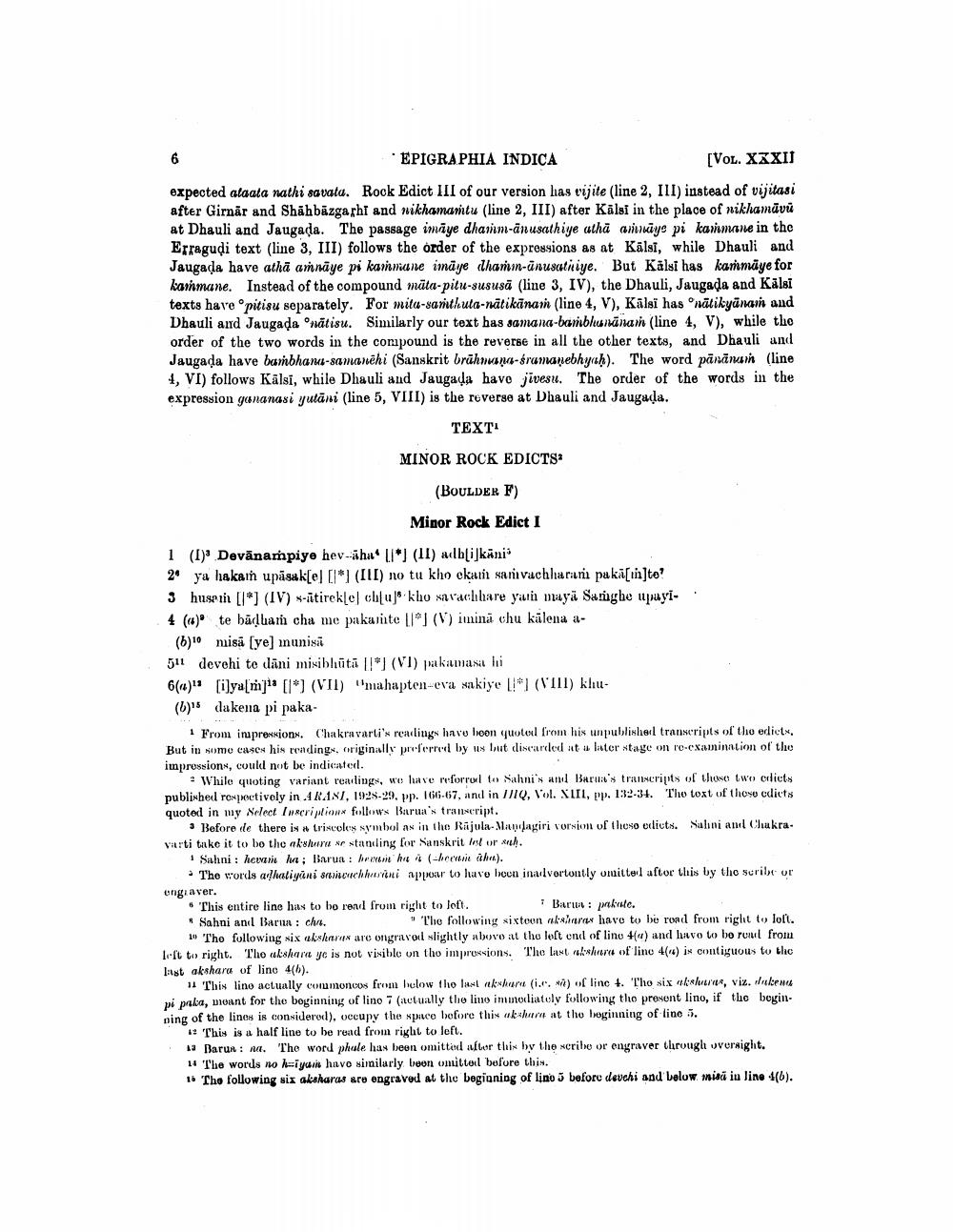________________
EPIGRAPHIA INDICA
[VOL. XXXII
expected ataata nathi savata. Rock Edict III of our version has vijite (line 2, III) instead of vijitasi after Girnar and Shahbazgarhi and nikhamamtu (line 2, III) after Kälsi in the place of nikhamāvā at Dhauli and Jaugada. The passage imaye dhamm-anusathiye atha amnaye pi kammane in the Erraguḍi text (line 3, III) follows the order of the expressions as at Kalsi, while Dhauli and Jaugaḍa have atha amnaye pi kammane imaye dhamm-anusathiye. But Kälsi has kammāye for kammane. Instead of the compound mata-pitu-sususā (line 3, IV), the Dhauli, Jaugada and Kālsi texts have pitisu separately. For mita-samthuta-nätikānam (line 4, V), Kalsi has nätikyanam and Dhauli and Jaugada natisu. Similarly our text has samana-bambhunanam (line 4, V), while the order of the two words in the compound is the reverse in all the other texts, and Dhauli and Jaugada have bambhana-samanehi (Sanskrit brahmana-śramanebhyah). The word pānānam (line 4, VI) follows Kalsi, while Dhauli and Jaugada have jivesu. The order of the words in the expression gananasi yutani (line 5, VIII) is the reverse at Dhauli and Jaugada.
TEXTI
MINOR ROCK EDICTS*
(BOULDER F)
Minor Rock Edict I
6
1 (1) Devanaṁpiye hev-aha [*] (11) adb[i]kāni
2 ya hakam upasak[e] [*] (III) no tu kho ekam samvachharam paka[n]to?
3 husein [*] (IV) satirekle] chu kho savachhare yath maya Samghe upayi
4(a) te badham cha me pakaite [*] (V) imina chu kälena a
(b)10 misa [ye] munisi
511 devehi te dani misibhūtā [*] (VI) pakamasa hi
6(a) [i]ya[m] [*] (VII) "mahapten-eva sakiye [*] (VIII) khu
(b)15 dakena pi paka
1 From impressions. Chakravarti's readings have boon quoted from his unpublished transcripts of the edicts, But in some cases his readings, originally preferred by us but discarded at a later stage on re-examination of the impressions, could not be indicated.
While quoting variant readings, we have reforrod to Sahni's and Barna's transcripts of those two edicts published respectively in ARANI, 1928-29, pp. 166-67, and in 1/1Q, Vol. XIII, pp. 132-34. The text of these edicts quoted in my Select Inscriptions follows Barua's transcript.
Before de there is a triscoles symbol as in the Rajula-Mandagiri vorsion of theso edicts. Salini and Chakra. varti take it to be the akshara se standing for Sanskrit let or sah.
1 Sahni hevan ha; Barua hewan ha (hecam aha).
The words adhatiyani samvachharani appear to have been inadvertontly omitted aftor this by the scribe or engraver.
This entire line has to bo read from right to left.
Barua pakate.
cha.
Sahni and Barua "The following sixteen aksharas have to be road from right to loft. 10 The following six aksharas are ongraved slightly above at the left end of line 4(a) and havo to be read from left to right. The akshara ye is not visible on the impressions. The last akshara of line 4(a) is contiguous to the last akshara of line 4(6).
11 This lino actually commoncos from below the last akshara (i.e. s) of line 4. The six aksharas, viz. dakena pi paka, moant for the beginning of line 7 (actually the line immediately following the present lino, if the begin ning of the lines is considered), occupy the space before this akshara at the beginning of line 5.
This is a half line to be read from right to left.
1 Barun na. The word phale has been omitted after this by the scribe or engraver through oversight.
14 The words no hiyam havo similarly been omitted before this.
15 The following six aksharas are engraved at the beginning of line 5 before devchi and below misa in line 4(b).




